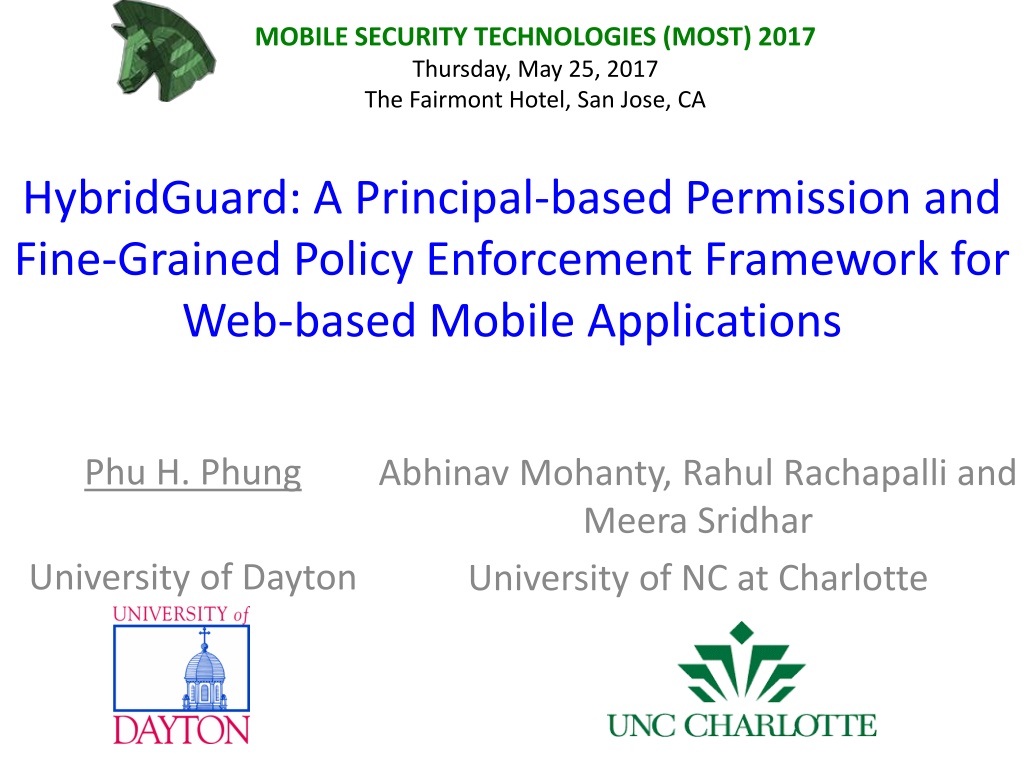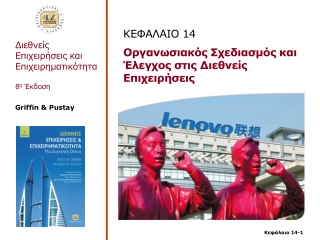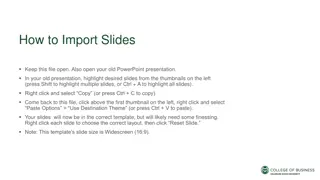
Hybrid Mobile App Development Frameworks and Security Protocols 2021
Explore the latest trends in hybrid mobile app development, emphasizing security protocols like permission models and JavaScript bridges. Understand how web-based mobile apps interact with device resources to enhance user experience and data protection.
Download Presentation

Please find below an Image/Link to download the presentation.
The content on the website is provided AS IS for your information and personal use only. It may not be sold, licensed, or shared on other websites without obtaining consent from the author. Download presentation by click this link. If you encounter any issues during the download, it is possible that the publisher has removed the file from their server.
E N D
Presentation Transcript
MOBILE SECURITY TECHNOLOGIES (MOST) 2017 Thursday, May 25, 2017 The Fairmont Hotel, San Jose, CA HybridGuard: A Principal-based Permission and Fine-Grained Policy Enforcement Framework for Web-based Mobile Applications Phu H. Phung Abhinav Mohanty, Rahul Rachapalli and Meera Sridhar University of NC at Charlotte University of Dayton
Web-based (Hybrid) Mobile Apps Business core code is developed in the Web technologies, i.e., HTML/JavaScript Run in a web container in a native mobile app Core code (HTML/Java Script) Core code (HTML/Java Script) Core code (HTML/Java Script) Core code (HTML/Java Script) 1
Hybrid Apps Interaction with Mobile Device Credit: http://www.xrgsystems.com/ 2
Hybrid App Architecture Bridge code is provided to allow the access from the web code to the device 3
JavaScript Bridge in Web-based Apps //implemented in a native language, // e.g., Java for Android addJavascriptInterface( new MyObject(), "myinterface"); //core code in JavaScript myinterface.sendSMS(..); myinterface MyObject() 4
Hybrid Mobile Frameworks The JavaScript Bridge is typically provided automatically by hybrid mobile development frameworks E.g., Cordova (PhoneGap), Ionic, Onsen, React Native, and more than 70 others JavaScript Bridge APIs are provided through plugins Native implementations and JavaScript interfaces 5
Permission Model in Mobile Apps Users can grant permissions for a mobile app to access the device resources such as geolocation, SMS, Once a permission is granted (either static or dynamic), there is no way to control how the app uses the permissions 6
Permission in Web-based Mobile Apps Any JavaScript code can access the exposed JavaScript bridge APIs Third-party JavaScript Local JavaScript myinterface MyObject() 7
Security in Web-based Mobile Apps Domain Whitelisting, e.g., in Cordova Allow code from some whitelisted domains can access Content Security Policy Limit the access of JavaScript code based on domain These mechanisms are coarse-grained: Once an access is granted, no more control on that 8
A Running Attack Scenario Third-party JavaScript code might misuse the devices resources or leak sensitive information via phone- based channels, e.g., SMS These cannot be enforced by whitelisted or CSP //Third-party JavaScript var g = geolocation.getLocation(); sms.send(..,g); Allowed in whitelisted domains and CSP geolocation, sms 9
The state-of-the-art Existing JavaScript security solutions Do not cover phone-related channels, e.g., sms Some hybrid app security solutions focus on a specific platform, e.g., WebView in Android [Georgiev et al., WWW 15], [Tuncay et al., CCS 16] Some approaches modify the hybrid framework, e.g., PhoneGap [Georgiev et al., NDSS 15], [Jin et al., ISC 15] Few work can enforce principal-based policies for mobile apps but do not protect the web environment, e.g., [Georgiev et al., WWW 15] 10
Our Motivation Provide a framework to allow hybrid app developers to define and enforce principal- based access control and fine-grained policies Do not depend on a specific mobile platform Work with any hybrid frameworks 11
Outline Motivation Our Approach - HybridGuard Implementation Evaluation Concluding Remarks 12
Threat Model Hybrid Apps are legitimate and trusted by the users Permissions are granted Content Security Policy (CSP) is deployed to e.g., present Cross-site Scripting Attacks In-scope threats - third-party JavaScript code, e.g., advertisements, allowed by the developers in CSP: 1. Benign but under the control of an attacker 2. Malicious by intentions 13
Our Approach Load a piece of JavaScript code under a principal name, i.e.,: Replace the original JavaScript inclusion <script src="http://third-party.com/script.js"> by our interface: loadJSwithPrincipal("principal","http://third- party.com/script.js") Wrap critical JavaScript APIs (Web APIs + JavaScript Bridge APIs) Enforce policies based on caller s principals 14
Our Approach Wrapping JavaScript APIs 16
HybridGuard 18
Wrapping JavaScript (Web/Bridge) APIs orig_sms_send=sms.send; 1. Keep the original reference sms.send = function(){ 2. Redefine the reference if (policyCheck(..)) execute(orig_sms_send,..); else{..} 3. Check policy to control the execution } Security code is injected before any other JavaScript code to monitor them sms.send( ); 19
Principal Management and Tracking Based on run-to-completion execution model of JavaScript We maintain a shadow stack to track the execution of each principal We catch dynamic generated code and event handlers Load these code under the same principal that generates them 20
Load and Run JavaScript Code under A Principal var code=get{JavaScriptcode}; var f=makeFunction(code); runAs( google ,f); shadowStack.push( google ); run(f); shadowStack.pop(); flush_dynamic_content( google );
Principal-based Permission Wrap the JavaScript Bridge APIs Grant access to these APIs based on principal E.g.: "trusted" principal can have full access to all resources "local" principal can have access to resources A, B "remote" principal can have access to resources C 23
Principal-based Permission Example Each resource Principal access control Read Write Create 24
Stateful and Fine-grained Security Policies Based on Behavior of the code Principal of the code E.g.: Disallow the sms.send if the untrusted principal has accessed the geolocation API 25
More Fine-grained Policy Patterns Resource bounds Policy Limit the number of accesses to a resource E.g.,: limit the number of sms send Whitelist Policies A resource access is allowed only under some conditions E.g.,: allow sms send to some predefined receipts History-based Policies Policies depending on the previous execution status E.g.,: no SMS sending after contact list is read Any custom policies, e.g., preventing UI attacks 26
Complete Mediation Web APIs: We apply the secure wrapper implementations for JavaScript in the literature Ensure that our monitor implementation is tamper-proof from potentially malicious code JavaScript bridge APIs Direct access to native APIs is disallowed We rely on app developers to identify bridge APIs and wrap them with our interface 27
HybridGuard Security Labeling all dynamically written content with the authoring principal Keeping original APIs with a protected lexical scope; wraps all channels generating JS code at runtime By lexical scoping 28
HybridGuard Security Unlabeled code always runs at the lowest privilege level A principal-tracking failure could lead to conservative rejection, but never a policy violation 29
Evaluation We have performed a small-scale evaluation on around 10 Android hybrid apps from Google Play Decompile the code and inject our framework manually We developed several hybrid apps invoking various plugins Our framework is integrated and tested on Android and iOS 30
Concluding Remarks We present HybridGuard A robust framework to specify and enforce principal- based and fine-grained security policies HybridGuard is developed in JavaScript can be deployed on various mobile platforms and hybrid development frameworks without modifying them We provide a wide range security policies that the app developer can use to mitigate potential attacks 33
MOBILE SECURITY TECHNOLOGIES (MOST) 2017 Thursday, May 25, 2017 The Fairmont Hotel, San Jose, CA Thank you! Phu H. Phung phu@udayton.edu http://academic.udayton.edu/PhuPhung






















